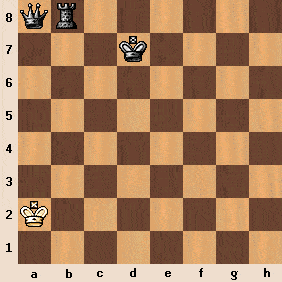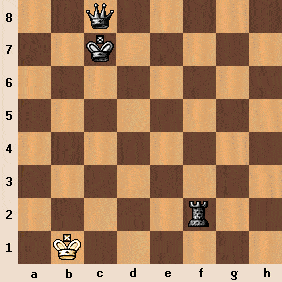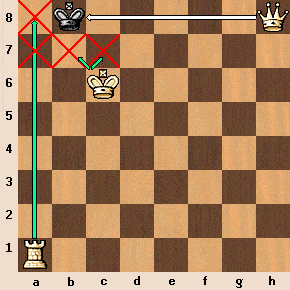Introductory Overview
The second easiest checkmates involve using the Queen and the Rook without the aid of the King (hereafter “QRK”), and the Queen, Rook & King v. King (“QRKK”). In this part we look at QRK & QRKK. In Part 4, we will turn to examining Queen & Two Rooks v. King (QRRK).
For what should be fairly obvious reasons, combining the Queen’s great power and mobility (having the combined powers of a Bishop and a Rook) with the Rook’s significant power (ability to check, checkmate, & control files and ranks), logically one can conclude that checkmating the opposing King is an easy task in a QRK endgame. As when using the Queen and King to checkmate, the player must be observant to prevent stalemating the opposing player’s King. Even if the opposing player has a pawn or some pawns, and/or one or a couple of other pieces, on the chessboard, checkmating can be relatively easy to accomplish.
However, as the opposing player’s forces on the chessboard increase in number or increase from minor to major pieces, checkmating with just the Queen and a Rook becomes increasingly problematical and in some situations impossible. The difficulties that a player may encounter in a Queen and Rook situation often are much less when the player has Queen and two Rooks. Yet, like in situations where the Queen may be overwhelmed by a superior opposing force by combining tactical and strategic maneuvering action by minor pieces, or minor pieces and a pawn or pawns, the same applies for overwhelming the Queen and a Rook, and even a Queen and two Rooks. Naturally, the task often is much more complicated for the opposing player in these situations.
Focus on Three Key Elements
The focus for checking and checkmating successfully is primarily on three key elements: material advantage, positional superiority, and pawn structure.
Queen & Rook v. King
The basic mating pattern in QRK mates is to use successive moves by the Queen and the Rook to force the opposing King to one of the sides of the chessboard (a wing or a back rank) – and prevent the opposing King from escaping back toward the center of the chessboard – where the Queen or Rook deliver checkmate on the wing or back rank.
QRK – Three Mating Patterns
- Queen & Rook where the Queen delivers checkmate while the Rook blocks the opposing King from moving off the checkmate file or rank.
- Rook & Queen where the Rook delivers checkmate while the Queen blocks the opposing King from moving off the checkmate file or rank.
- Queen/Rook where the Queen delivers mate and blocks the opposing King from moving off the checkmate rank, while defended and protected by a Rook. In this later example, the Queen is located on a square adjacent to the checkmate square upon which the opposing King is located.
The following five diagrams show the three mating patterns for QRK mates.
|
Diagram QRK #1 Queen-Rook Checkmate in the a-file 
|
Diagram QRK #2 Rook-Queen Checkmate in the a-file 
|
|
Diagram QRK #3 Queen-Rook Checkmate in the 1st Rank 
|
Diagram QRK #4 Rook-Queen Checkmate in the 1st Rank 
|
|
Diagram QRK #5 Queen/Rook Checkmate Corner Square Queen Defended by Rook 
|
|
In the third variation, Queen/Rook mates, there are two possible positions for the Queen versus the opposing King for each rank in which the Queen would be located (2nd rank or 7th rank) or each file in which the Queen would be located (a-file or g-file). Either (1) adjacent to the opposing King diagonally as in the above example and this works only for checkmates on one of the four corner squares, or (2) vertically aligned in the same file for checkmates on the 1st and 8th ranks, or horizontally aligned for checkmates in one of the wings (a-file or h file). Thus, in the above example Black could have positioned the Queen at a2 and still checkmated the White King (vertically aligned in the a file).
Move Order & Calculation
Now let’s step it up to a higher level of thinking to develop further the concept of move order & calculation within the framework of QRK mating patterns. Be assured that this exercise tests nothing but basic principles, although some have told me it has sorely tested their patience as well. In the following board position, Black to move. How many different move orders may Black make from this position to mate in two?
|
Diagram QRK #6 Test Problem Queen-Rook Checkmate in the 1st Rank 
|
Scroll down a few lines for the answer.
Answer to the test problem: 36 possible move orders to mate in two.
The test problem was designed to test your ability to distinguish between forced checkmates versus opportunistic checkmates. A forced checkmate occurs when the opposing player cannot avoid checkmate no matter what he or she does. An opportunistic checkmate occurs when the opposing player moves wrong and gives a checkmate sooner than would otherwise be available. The test problem also required the ability to spot a possible stalemate. The two-move checkmates (forced and opportunistic) are shown in the solutions table below. The two-move simple checkmates (forced and opportunistic) are shown in the solutions table below. These are presented in order from Black initially moving the Queen to available squares in the a-file to which it may move and accompish mate, then to the available squares in the b-file, and so on across the files – c-file, e-file, g file, and the h file. The Queen cannot checkmate in two if it moves to d8 or f8, but has checkmate in three from those squares by moving the Queen diagonally (using its Bishop power) on the second move from those squares to one of the wings (a-file or h file) or a square in an internal diagonal line. These lines are reviewed after the solutions table below. If the Queen moved to c3, then it would stalemate Black’s King. Checkmate in two if Black moves Qb8+ is only possible if White moves Ka1, not Kc1. However, if White moved Kc1 then Black has checkmate in three moves: 1…Qb8+ 2.Kc1 Qb2+ 3.Kd1 and now Black has checkmate in one of three ways…Qb1# or Qa1# or Qd2#. Therefore, this is an example of an opportunistic checkmate situation, where White gives Black a checkmate sooner when White moves to Ka1 instead of Kc1 in reply to Black’s Qb8+.
|
|
Now let’s review the problem from the perspective of using the Queen’s Bishop power after moving to either d8 or f8.
Qd8: Using the a-file, these lines are available for checkmating on that wing:
- 1…Qd8 2.Ka1 Qa5+ 3.Kb1 Qe1#
- 1…Qd8 2.Kc1 Qa5 3.Kb1 Qe1#
- 1…Qd8 2.Kc1 Qa5 3.Kd1 Qa1#
- 1…Qd8 2.Kc1 Qa6 3.Kd1 Qd2#
Qd8: Using the h-file, these lines are available for checkmating on that wing:
- 1…Qd8 2.Ka1 Qh4 3.Kb1 Qh1#
- 1…Qd8 2.Kc1 Qh4 3.Kb1 Qh1#
- 1…Qd8 2.Kc1 Qh4 3.Kd1 Qh1#
Qd8: Using internal diagonals, these lines are available:
- 1…Qd8 2.Ka1 Qe7 3.Kb1 Qe1#
- 1…Qd8 2.Ka1 Qf6+ 3.Kb1 Qb2#
- 1…Qd8 2.Ka1 Qg5 3.Kb1 Qg1#
- 1…Qd8 2.Kc1 Qb6 3.Kd1 Qb1#
- 1…Qd8 2.Kc1 Qe7 3.Kb1 Qe1#
- 1…Qd8 2.Kc1 Qf6 3.Kd1 Qa1#
- 1…Qd8 2.Kc1 Qg5 3.Kb1 Qg1#
- 1…Qd8 2.Kc1 Qg5 3.Kd1 Qg1#
Neither Qb6 nor Qc7 are options to checkmate in three if 2.Ka1. This is because 2.Ka1 Qb6 stalemates, while 2.Ka1 Qc6 3.Kb1 and Black cannot mate on the next move, and would need to make one extra move for mate in four. The available lines are:
- 1…Qd8 2.Ka1 Qc7 3.Kb1 Qc2+ 4.Ka1 Kc1#
- 1…Qd8 2.Ka1 Qc7 3.Kb1 Qc2+ 4.Ka1 Ka2#
- 1…Qd8 2.Ka1 Qc7 3.Kb1 Qc4 4.Ka1 Kc1#
- 1…Qd8 2.Ka1 Qc7 3.Kb1 Qc5 4.Ka1 Kc1#
- 1…Qd8 2.Ka1 Qc7 3.Kb1 Qc6 4.Ka1 Kc1#
- 1…Qd8 2.Ka1 Qc7 3.Kb1 Qc6 4.Ka1 Kh1#
- 1…Qd8 2.Ka1 Qc7 3.Kb1 Qc8 4.Ka1 Kc1#
Note that 3…Qc3 results in stalemate. This result shows a general principle applicable to checkmating, drawing, and stalemating. While checkmate opportunities increase as the number of moves to checkmate increases, the possibilities for making a blunder, drawing, and stalemating also increase.
Another general principle for checkmating is that as the number of moves to checkmate increases, then more likely than not a player will have to make an intermediate move to force the King to the checkmate square. In addition to the above examples, we saw an earlier example as the alternative line to the previous opportunistic checkmate example (1…Qb8+ 2.Ka1 Qb2#). Let’ look at another board position to see the employing of the intermediate moves to mate. Black has utilized the tactical and strategic principle of a Rook on the 7th rank to trap White’s King on White’s back rank (1st rank).
|
Diagram QRK #6A Queen-Rook Checkmate in the 1st Rank Intermediate Move Alternate 
|
White can mate directly in several ways in two moves, for example: 1.Qe8 Kc1 (or Ka1) 2.Qe1#. White also can mate in three moves via multiple mating nets such as: 1…Qb8+ 2.Kc1 (if 2.Ka1 Qb7#) 2…Qb2+ (continuing the mating net and driving Black’s King to a “bad square” – the checkmate square d1) 3.Kd1 giving Black checkmate in one of three ways…Qb1# or Qa1# or Qd2#. As with the test problem, there are many mating patterns available.
However, let’s see White employ an intermediate move with White’s King, positioned at c7 blocking White’s Queen movement down the c-file , as part of a mating net.
1…Kb7 or 1…Kd7 {intermediate move clearing the c-file for Black’s Queen to move} (if 1…Ka1 2.Qc1#) 2.Kc1 Qb2+ {Qc4, Qc5, Qc6, or Qc7 all accomplish the goal for checkmating White’s King, but not Qc3, which results in stalemate. Black’s Queen move continues the mating net and drives Black’s King to a “bad square” – the checkmate square d1} 2…Kd1 {and now as before Black can checkmate in one of three ways…Qb1# or Qa1# or Qd2#}
One of two different or more intermediate moves, or a particular intermediate move directly, thus may open the possibility to checkmate the opposing King in more and/or different mating patterns and mating nets. One might say, why use an intermediate move mating net when there is a much simpler direct mating net to “see” and use? The use of an intermediate move mating net in this problem naturally would be unwise. Why?
We saw that making the intermediate move opens up the possibility for Black to blunder and stalemate White’s King. Limiting the possibilities that a player may blunder naturally will increase the player’s chances of winning the game. However, this problem is one of the simplest positions from which to checkmate. More complex ones with more pieces and/or pawns on the board might not be so easy. Understanding the use of intermediate moves could increase the player’s ability to mate by increasing the available mating nets in more complex positions. Also, some mating patterns especially involving the use of a Rook or Two Rooks, Bishops and/or Knights, in fact require the use of one or more intermediate moves to close the mating net and accomplish checkmate.
Principle of Intermediate Move
A player makes an intermediate move with a piece or pawn advance forcing the King to a bad square – which can be the checkmate square, or to gain some other advantage (e.g., gaining a piece and material advantage, opening a line, blocking a line, and so on), or to avoid a stalemate position.
Employing an intermediate move is very common not only in checkmating, where it is seen time-and-time again, but as a general tactical and strategic maneuver during the middlegame and endgame. More rarely, the principle may come into play in openings, especially non-traditional openings.
Two other principles also exhibit the conceptual idea behind the Principle of Intermediate Move. These are The Principle of Short Positioning and The Principle of Retreat. Both of these principles can be used, and often are used, in QKK and QRK endgames. These principles are defined and reviewed more extensively in the Simple Rook Checkmates tutorial, because they invariable are used especially in those endgames. The reason for this is the Rook does not have the Bishop’s power, like the Queen.
For now, let’s look at an example of The Principle of Retreat without a Queen on the board. The following board position shows an example of maneuvering and employing The Principle of Retreat to checkmate the opposing King. Black to move and mate in three.
|
Diagram QRK #7 Principle of Retreat Example Problem (no Queen) 
|
1…Kh3!! 2.Kg1 Rf3! {retreating Black’s Rook one square vertically in the f-file prevents White’s King from moving to f1 and drives him back to a “bad square” – the checkmate square – h1; Black could have retreated to f4, f5, f6, f7, & f8 with the same result} 3.Kh1 Rf1#.
Two Important General Principles
From the discussions in QKK and this part on QRK, we are able to discern two important general principles to keep in mind when maneuvering to checkmate the opposing King, and as importantly when attempting to prevent being checkmated.
- As the number of moves to checkmate increases, the more opportunities are present for the player to commit a blunder, and more opportunities will open up for the opposing player to obtain a stalemate, a Three-Love Repetition Draw, or more rarely a Fifty-Move Draw; and
- As the number of moves to checkmate increases, then more likely than not a player will have to make an intermediate move to force the King to the checkmate square.
Therefore, it is always best to try to checkmate in as few moves as possible.
Now let’s continue with examining the three-move checkmates from Qf8 for checkmates on the wings.
Qf8: Using the a-file, these lines are available:
1…Qf8 2.Ka1 Qa3+ 3.Kb1 Qb2#
1…Qf8 2.Kc1 Qa3+ 3.Kb1 Qb2#
1…Qf8 2.Kc1 Qa3+ 3.Kd1 Qa1#
Qf8: Using the h-file, these lines are available:
1…Qf8 2.Ka1 Qh6 3.Kb1 Qh1#
1…Qf8 2.Kc1 Qh6+ 3.Kb1 Qh1#
1…Qf8 2.Kc1 Qh6+ 3.Kd1 Qh1#
Qf8: Using internal diagonals, these lines are available:
1…Qf8 2.Ka1 Qd6 3.Kb1 Qd1#
1…Qf8 2.Ka1 Qe7 3.Kb1 Qe1#
1…Qf8 2.Ka1 Qg7+ 3.Kb1 Qb2#
1…Qf8 2.Ka1 Qg7+ 3.Kb1 Qg1#
1…Qf8 2.Kc1 Qg7 3.Kb1 Qb2#
1…Qf8 2.Kc1 Qg7 3.Kd1 Qa1#
1…Qf8 2.Kc1 Qg7 3.Kb1 Qg1#
1…Qf8 2.Kc1 Qg7 3.Kd1 Qg1#
1…Qf8 2.Kc1 Qd6 3.Kb1 Qd1#
1…Qf8 2.Kc1 Qe7 3.Kb1 Qe1#
The last line above is another example of an opportunistic checkmate because if 2…Qe7 3.Kd1 and Black cannot checkmate on the next move and would have to take one extra move to checkmate: 1…Qf8 2.Kc1 Qe7 3.Kd1 Qe2+ 4.Kb1 Qe1#. This is another example of the Principle of Intermediate Move.
The above checkmates in three are not, in fact, all the possibilities. There are many more checkmates in three available from the problem start position. The above test problem then highlights quite well the great power of the Queen. Especially this is true when an opposing King is trapped on one of back ranks by a player’s Rook (positioned on the opposing player’s second rank (Black with Rook on 2nd rank for White with White’s King in back rank (1st rank); White with Rook on 7th rank for Black with Black’s King in back rank (8th rank). Similarly true is when the opposing King is in the a-file and the Rook is positioned in the b-file; or the opposing King is in the h-file and the Rook positioned in the g-file. The ability to develop large amounts of mating patterns and mating nets within two to three moves can be staggering to say the least.
Queen, Rook, & King v. King
The next level for Queen Simple Checkmates is Queen, Rook, & King v. King (QRKK). An example of this mating pattern was shown as the simple checkmate used in The Objective of Chess section. This variation utilizes the King in combination with the Queen and Rook, whereby the Queen and King take away the opposing player’s escape squares while the Rook delivers checkmate, or the Rook and King take away the opposing players escape squares while the Queen delivers checkmate. This simple checkmate type does not have to occur on one of the sides of the chessboard, although generally it easier to checkmate on one of the sides of the chessboard rather than on one of the inner or center files or ranks. Let’s view the QRKK simple checkmate from The Objective of Chess tutorial.
|
Diagram QRKK #1
|
I chose this example so that we may review how basic principles are at the heart of common pattern themes for simple checkmates, and indeed complex checkmates as well, based upon the central theme of the anatomy of mate patterns. In the above simple checkmate for example, we see the basic principles of:
- one of the Rook’s powers…control a file (and in this example, ironically the a-file ) to block one of the flight paths for the opposing King’s; and
- the King being used to block movement of the opposing King; and
- the Queen using just one of her powers (the same powers as a Rook…to attack and check the opposing King along a rank while controlling that rank).
The Queen’s additional powers of a Bishop to attack and check along, and to control, a diagonal…are not used in this example. Similarly, the Rook’s additional power to directly attack and check the opposing King is not used. You should note, however, that the Rook’s power to attack and check the opposing King is used as the blockade device through the threat of attacking and checking the opposing King if it moved to the a-file .

